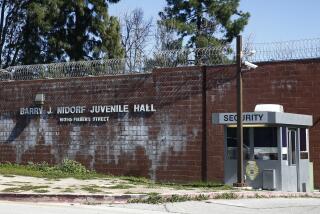State Accused of Shortchanging L.A. Children : Social services: County youngsters are getting only half the money they should from Healthy Start, critics charge. Many needy school districts will receive nothing.
Angry at what they say is yet another example of the shortchanging of Los Angeles children by the state, Los Angeles child advocates and officials charged Wednesday that the county’s children are getting only half the money they deserve under Gov. Pete Wilson’s innovative Healthy Start program.
The county has one-third of all the state’s children, but the state plans to spend only one-sixth, or $3.3 million, of its $20-million budget in Los Angeles County, the Los Angeles advocates said Wednesday.
“We’re going to register a very strong protest and demand that business not be allowed to go on as usual with the children of this county getting less of the budget than they need and deserve,” said Sharon Watson, executive director of the Los Angeles County Children’s Planning Council, whose members include a variety of public and nonprofit agencies.
The Healthy Start program was announced by Wilson in 1990 as the second in a “10-point preventive program” of major initiatives emphasizing preventive health care and education. Healthy Start is aimed at providing health and social services at or near schools accessible to children and their families. This is the first year the program is to be funded.
The program was welcomed by many children’s advocates in Los Angeles. But that enthusiasm turned to disappointment and anger as the state Department of Education began sending out notices last week as to which grant applications from throughout the state had been approved. Many of the most needy of the county’s school districts, including some racked by civil disturbances in April, will receive little or nothing.
“There is this sense in Sacramento that Los Angeles County is getting more than its share because of sheer size, but almost the inverse is true,” said Deanne Tilton, executive director of the county’s Interagency Council on Child Abuse and Neglect. “And this is tragic for children who happen to be born here, who happen to need health care here, and who happen to need education here.”
Jane Henderson, who oversees Healthy Start as assistant superintendent of public instruction for the state Education Department, acknowledged some apparent spending disparities. Still, she said in an interview, more Los Angeles children may have access to Healthy Start services than it seems.
Although local officials complain that money spent per child in Los Angeles is inequitably low, Henderson said that formula is misleading because many children who lack services at their own schools can find them at nearby campuses.
The bottom line, according to Henderson, is that the disparity between funding and need in Los Angeles is only about 3.5%.
The grant proposals submitted by school districts throughout the state were rated by an independent panel of experts. With few exceptions, the highest-rated proposals were funded, Henderson said, adding that this year’s recipients are required to teach other districts how to successfully apply for future grants and run Healthy Start programs.
News of the funding became public at a meeting of the new Los Angeles Children’s Planning Council on Wednesday, where it was greeted with dismay by officials ranging from Peter Digre, head of the Los Angeles Department of Children’s Services, to Dr. Areta Crowell, director of the Los Angeles County Mental Health Department.
Crowell said that many better-funded school districts, particularly in Northern California, are able to spend more time and money preparing professional grant proposals.
To complicate matters further, the deadline for the proposals was April 30, when violence was sweeping Los Angeles. The deadline was extended for nearly a month for Los Angeles applicants, Henderson said. Still, Compton Unified School District, arguably one of the most beleaguered in the nation, was able to submit just one of the six proposals it had hoped to.
Compton Unified officials could not be reached for comment Wednesday.
“I’m very cognizant of the fact that there are areas that have extremely high areas of need, particularly Compton and Inglewood, which were in the riot zone and will not be funded this go-round,” Henderson said. “But we really view this as just the start of what we hope will be ultimately a statewide program.”
The state received a total of 478 proposals statewide and approved 150. Los Angeles agencies submitted 100 grants, out of which 26 were approved. The program funds two types of proposals: planning grants of up to $50,000 for one or two years, and operational grants of up to $400,000 for three years.
The Los Angeles Unified School District received $2.5 million of the county’s $3.3 million, which a spokesperson said was helpful, but still is not as much as the district deserves because of its enormous student population.
Per capita distribution of state funds for children’s projects has become a crucial cause for Los Angeles children’s advocates over the last few years. Instead of distributing funds by child, they say, funds are often distributed according to legislative districts or to assist rural counties, which complain they are often overlooked.
The Children’s Planning Council was created last year to help establish priorities for the multitude of private and public agencies that run programs for children in Los Angeles County. The council passed a motion Wednesday to urge all local officials to file complaints “of outrage” over funding of the Healthy Start program.
Experts say Los Angeles County is often on the short end of state funding when it comes to children. For example, officials said, Los Angeles County received only $4,573 in child abuse prevention funds under a federal challenge grant program. Tiny Alpine County got $24,560.
More to Read
Sign up for Essential California
The most important California stories and recommendations in your inbox every morning.
You may occasionally receive promotional content from the Los Angeles Times.










